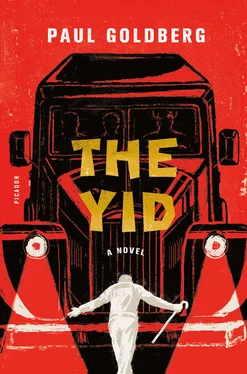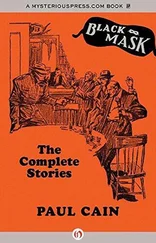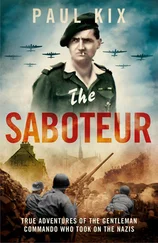KOGAN: I didn’t kill him, komandir , but he is a dead man still.
LEVINSON: How can you tell?
KOGAN: I am a doctor.
LEVINSON: But you’re the kind that cuts!
KOGAN: Do you see this? Nit umkern zikh keynmol … keynmol … keynmol. He is redder than a crawfish, even his feet. Look on his lips … di lipn … zet … nu … kukt zikh ayn. He is swelling. And if you call this breathing, my name is Mrs. Robeson. O, tut a kuk … Look there, look there — we are done. Just put him on the sofa. Or the floor … Azoy … Gey, gey!
* * *
As it has been established, shortly before 5 a.m. on March 1, Major Khrustalev tells the guards that the old man gave his blessing for everyone at the dacha to go to bed, and the guards enthusiastically carry out the order.
This is, most likely, correct.
The playwright-historian Radzinsky, who obtained this information by interviewing the last surviving guard, can’t possibly account for Major Khrustalev’s whereabouts between 4 a.m., when the czar’s dinner guests piled into a Moscow-bound limousine, and 5 a.m., when the major dismissed the guards.
Radzinsky is in no position to know that at 4:57 a.m., the plotters, as they make their exit, untie Khrustalev, take a strip of red cloth out of his mouth, and apologize for any pain and discomfort they might have caused.
“Have you heard? The czar is dead,” says the tall, elderly lieutenant.
“ Almost dead,” the homely Negress adds. Her voice is deep, her Russian perfect.
“It happened on your watch,” a soldier says. “You should be proud.” He has a woman’s voice.
“You led us to him,” the Negress adds. “A sheynem dank . Are you, perchance, a Yid?”
“If I were you, I’d send the guards to sleep,” Paul Robeson says. “Have some more wine, relax, gey shlofn. ”
Khrustalev takes Robeson’s advice.
The following evening, Stalin is found unconscious, in a puddle of urine on the sofa in his study.
It’s no surprise that the story of three chekisty delivering Paul Robeson and his wife for an interrogation evaded Radzinsky.
Robeson’s visit was an unusual event at the Nearby Dacha, but security guards are not talkative people. Radzinsky had no basis for asking specifically about the Robesons, and no information came his way.
Soon after these events, Major Khrustalev falls ill and dies.
On March 1, 1993, a man in a dark-colored Western trench coat walks through the white marble gates of the Malakhovka Jewish cemetery.
Disregarding the Jewish tradition of eschewing flowers at cemeteries, he cradles two bouquets of white lilacs that he purchased from a Chechen woman at a place that is still stubbornly called the kolkhoz market.
The elderly pauper at the gate looks up. The world has changed so completely — even the USSR, one of its pillars, dissolved before the pauper’s eyes two years ago.
People who search for life’s meaning in headstones that connect them with the past look past cemetery paupers. This man seems different.
“Zayt azoy gut, brengt mir tsu Shloyme Levinson un Aleksandr Kogan,” he says in Litvak Yiddish.
“Di Royte-armeitses?” asks the pauper, looking up. The Red Army soldiers? This visitor is no Jew. His skin is black.
Years ago, people said that there used to be a Negro in Malakhovka. He was rumored to have first come there in late February of 1953 and returned occasionally for over a decade. He was known to be a close friend of di Royte-armeitses . Now they lie beneath identical white marble monuments.
It is said that people looked for the Negro to show up at Levinson’s funeral in 1968, and Kogan’s a year later. But he wasn’t there.
The old men had no families. Only a Russian woman who first came to Malakhovka to work at the bottle redemption station beneath GORPO visited their graves. She went to night school at the pedagogical institute and, later, became a much-admired teacher of Russian literature. She vanished in the 1970s, and the graves are visited no more.
“Kimt mit mir, Reb Neger,” says the pauper, motioning for the man to follow. Come with me, Reb Negro.
The two step off the path of the cemetery alley.
“Ot zaynen zey,” he says, pointing at the identical headstones adorned with matching bas-reliefs of Red cavalrymen. Here they are.
The horsemen on the graves run toward each other, their swords brandished. The Negro hands the pauper a ten-dollar bill, a fortune.
From a distance, the pauper observes the old Negro cover his face, then straighten as his lips move in what seem like the words of the Hebrew prayer for the dead.
Lewis (for this is, of course, he) isn’t bound by Jewish traditions. He doesn’t observe the anniversary of every death. Even after returning to America, he chose March 1 as his day of commemoration for all the people who were dear to him in his prior life.
“Forty years,” he says out loud.
After abandoning the Black Maria in front of the kolkhoz market on the morning of March 1, 1953, Lewis returned to his real passion, engineering. For forty years, most of them back in America, he worked in steel mills, then as an engineer with the American Motors Corporation.
Of course, his sympathies were still firmly with the Left. Sometimes he imagined himself participating in the civil rights movement and protesting against the war in Vietnam. He did all those things, but only in spirit. His body was beyond his control. It didn’t protest, didn’t march.
After its final, decisive confrontation with evil, it refused to join new struggles. Forty years later, he is still tormented by questions about the night of Stalin’s collapse.
“Forty years,” echoes another voice.
This is a woman, in her late fifties, heavyset, her hair dyed out-of-the-bottle red.
They embrace, imagining alternative scenarios for their lives, starting with one where she agrees to follow him to Siberia in March of 1953; or where he transfers to Moscow, giving rise to a dynasty of brown children, including a Pushkin or two; or where they meet again before he leaves for America, or she for Israel.
Separating, they look stiffly at each other. Their meeting is not accidental. Lewis tracked her down a year ago in a town near Tel Aviv and offered to pay for her trip to Moscow.
Though prosperity eluded Kima, she declined Lewis’s offer of money and bought her own ticket.
“Why did you want to see me?” she asks.
“There is something I must understand before I die,” he says. “About that night, about Stalin.”
He watches her short neck stiffen.
“Why was Kogan so certain that Stalin wouldn’t recover?”
Silence.
“He was a surgeon, not a clown. Levinson was that. No, Kogan wasn’t venturing a guess. Did he know something the rest of us did not?”
More silence.
“And what about Stalin turning ‘red as a crawfish,’ as Kogan put it? I can see why his face was red, but why his feet? A rapid rash is not a symptom of a stroke. Neither is swelling. Yet he was red and swollen.”
Another load of silence.
“Why was the syringe missing from Kogan’s doctor’s bag? He was a thorough man.”
“What do you think?” she asks, her voice barely audible.
“I think der komandir was wrong to model his blood ritual on the Passover Seder. Should he have chosen Purim? A fitting choice, since Purim plays are the beginning of Yiddish drama…”
“Must you?” asks Kima.
“Suppose I’m right, and it’s a purimspiel. Then who was Mordechai, and who was Esther? Imagine Esther mit syringe.”
Читать дальше












